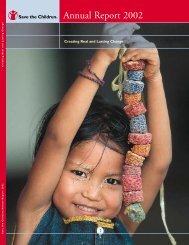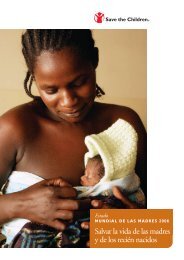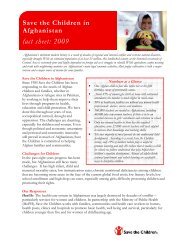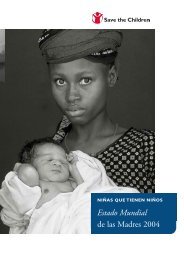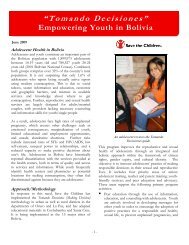Adolescent Sexual and Reproductive Health Toolkit for - UNFPA
Adolescent Sexual and Reproductive Health Toolkit for - UNFPA
Adolescent Sexual and Reproductive Health Toolkit for - UNFPA
Create successful ePaper yourself
Turn your PDF publications into a flip-book with our unique Google optimized e-Paper software.
safe place <strong>for</strong> the survivor to stay if there is risk of<br />
retaliation by the perpetrator <strong>and</strong>/or re-victimization<br />
by the family or community.<br />
• Awareness-raising: All stakeholders, including<br />
community members, adolescents, health staff,<br />
staff from other sectors, humanitarian agents <strong>and</strong><br />
security personnel, should be made aware of the<br />
problem of sexual violence <strong>and</strong> the risks faced by<br />
women, girls <strong>and</strong> other high-risk adolescents.<br />
<strong>Sexual</strong> violence prevention strategies should be<br />
communicated <strong>and</strong> in<strong>for</strong>mation about where help is<br />
available <strong>and</strong> how to access it should be made<br />
available. <strong>Adolescent</strong>s should know that confidential<br />
services are available <strong>for</strong> all survivors,<br />
regardless of age or marital status.<br />
• During MISP implementation, this in<strong>for</strong>mation<br />
can be provided through MISP orientation<br />
sessions, which should include sessions <strong>for</strong><br />
adolescents, as well as through IEC materials<br />
distributed in the community. Community<br />
health workers (CHWs) <strong>and</strong> traditional birth<br />
attendants (TBAs) should also be in<strong>for</strong>med, so<br />
that they can link young survivors to services.<br />
As the emergency stabilizes, health in<strong>for</strong>mation<br />
<strong>and</strong> education campaigns can convey these<br />
messages with the involvement of adolescents.<br />
• It is important to raise awareness about SEA<br />
among humanitarian personnel, including<br />
personnel from UN agencies, peacekeeping<br />
<strong>for</strong>ces, <strong>and</strong> NGOs. For all humanitarian<br />
workers, a zero-tolerance policy <strong>for</strong> SEA<br />
must be en<strong>for</strong>ced.<br />
• Other uni<strong>for</strong>med services (police, military)<br />
should be sensitized about GBV <strong>and</strong> its<br />
consequences. The health cluster <strong>and</strong> the RH<br />
Officer should advocate with officials to ensure<br />
that zero-tolerance policies are in place <strong>for</strong><br />
SEA among uni<strong>for</strong>med personnel.<br />
• Community linkages: ASRH programs should try<br />
to link with any networks already existing in the<br />
community to reach adolescent survivors <strong>and</strong> to<br />
disseminate prevention messages. For example,<br />
CHWs <strong>and</strong> TBAs can provide in<strong>for</strong>mation to the<br />
community on prevention measures <strong>and</strong> clinical<br />
services available. They may be aware of young<br />
survivors of sexual violence in the community <strong>and</strong><br />
should know how to refer these clients <strong>for</strong> clinical<br />
services as well as legal <strong>and</strong> psychosocial support.<br />
Religious or other community leaders may also be<br />
good resources <strong>for</strong> identifying problems within the<br />
community <strong>and</strong> <strong>for</strong> disseminating in<strong>for</strong>mation.<br />
GBV is a broader term that encompasses a wide<br />
range of issues, including sexual violence, trafficking,<br />
domestic violence, <strong>and</strong> harmful traditional practices<br />
such as female genital cutting (FGC) <strong>and</strong> <strong>for</strong>ced early<br />
marriage. As crisis situations stabilize, other <strong>for</strong>ms of<br />
GBV are reported more frequently, although sexual<br />
violence continues to be an important problem <strong>for</strong><br />
adolescents. Once the emergency has stabilized <strong>and</strong><br />
comprehensive RH services are introduced, multisectoral<br />
collaboration is important to ensure that:<br />
• GBV awareness-raising <strong>and</strong> prevention activities<br />
are carried out at the community level, with adolescents,<br />
with military <strong>and</strong> peacekeepers, <strong>and</strong> with<br />
humanitarian workers;<br />
• the community <strong>and</strong> adolescents are involved in<br />
developing GBV prevention strategies <strong>and</strong><br />
improving the mechanisms <strong>for</strong> h<strong>and</strong>ling complaints<br />
about SEA;<br />
• staff are trained (or re-trained) in screening <strong>for</strong><br />
GBV <strong>and</strong> in sexual violence prevention <strong>and</strong><br />
response systems;<br />
• appropriate, confidential, ethically-sound data<br />
collection, storage, analysis, <strong>and</strong> dissemination<br />
systems have been established;<br />
• the systems to prevent <strong>and</strong> address GBV that were<br />
established during the acute phase are continued<br />
<strong>and</strong> strengthened; <strong>and</strong><br />
• the community is involved in referring GBV survivors<br />
to health facilities <strong>and</strong> other support services.<br />
<strong>Adolescent</strong>-Inclusive Implementation of the misp<br />
31


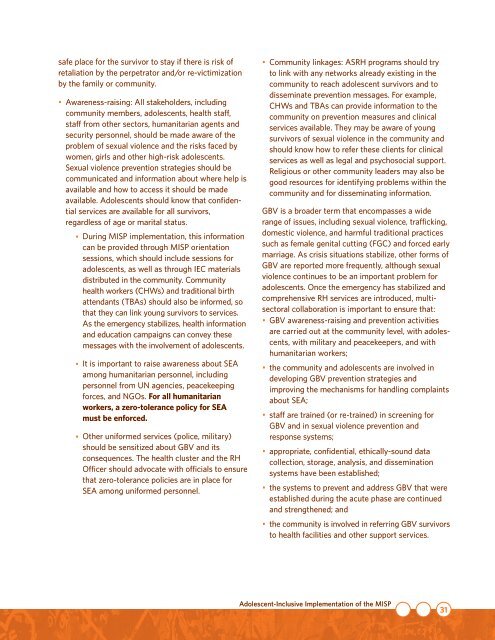

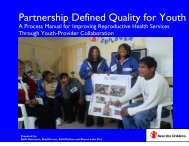

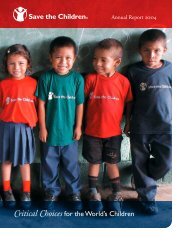
![View full document [PDF 3.39 MB] - PreventionWeb](https://img.yumpu.com/27308954/1/190x245/view-full-document-pdf-339-mb-preventionweb.jpg?quality=85)
